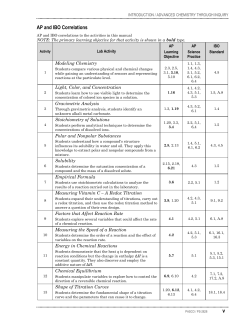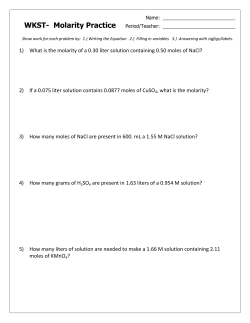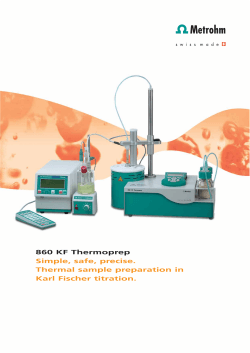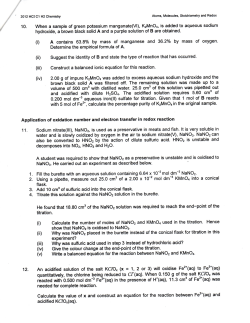
IA State Chem Dept â Titration
Acid-Base Titration Simulation Handout Go to the following site to complete the virtual experiment. IA State Chem Dept – Titration Procedure: 1. Select Type of Reaction: Strong Acid vs. Strong Base 2. Fill the buret with: Base 3. Select the acid and base: HCl and NaOH 4. Select the indicator: phenolphthalein 5. Notice the volume of the acid and the molarity of the acid at the bottom of the screen; record these values in the data table 6. Push the slider up to add a volume of base; if you use the red button you can add the base dropwise; which is especially important right before the acid and base have reached an endpoint (neutralization). You can use the dropwise button for the entire titration if you choose so that you do not miss the endpoint. 7. Watch the flask for a color change to a hot pink 8. If you overshoot the endpoint by adding base too quickly, you will have to repeat the experiment by starting over at Step 1. 9. When you reach the endpoint by changing the color of the acid in the flask, calculate the molarity of the base by using the following formula: (Vacid)(Macid)(# eq) = (Vbase)(Mbase)(# eq) Show work for your calculations on the handout. For this first titration, the number of equivalents is equal to one because HCl contains only one ionizable H+ and NaOH contains only one OH- group. 10. When you have obtained a molarity for the base, enter into the box labeled ____M. If you are correct, the program will tell you so. 11. Click on the Graph button and view the graph of the titration. The equivalence point of the reaction can be read from the graph. Pick the midpoint of the vertical section of the graph. Record this value in the data table. 12. Repeat Steps 1-11 again for a strong acid and strong base, but choose a diprotic acid and a monobasic base. (two Hs and one OH) This time when you calculate, the number of equivalents for the acid will be two. 13. Repeat Steps 1-11 again for a weak acid and a strong base. Choose any base you want and any indicator you choose. Watch the calculations based on the number of equivalents. Acid-Base Titration Simulation Handout Data Table: Acid Formul a Weak or Strong? Base Formula Weak or Strong? Volume of Acid (mL) Molarity of Acid (M) Volume of Base (mL) Equivalence Point Calculations for Molarity of Base using Strong Monoprotic Acid/Strong Monobasic Base: Calculations for Molarity of Base using Strong Diprotic Acid/Strong Monobasic Base: Calculations for Molarity of Base using Weak Acid/Strong Base: Questions: 1. What does the term “triprotic” mean? 2. How many equivalents does Al(OH)3 have? 3. When a strong base and a strong acid combine, what is the pH of the salt that is created? 4. When a strong base and a weak acid combine, what is the pH of the salt that is created? 5. When a weak base and a strong acid combine, what is the pH of the salt that is created? 6. When a weak base and a weak acid combine, what is the pH of the salt that is created? 7. What is the purpose of using an indicator for a titration? Submit the completed handout to the dropbox labeled Acid-Base Titration Simulation through the dropbox link on the navigation bar. Rubric: Data Table: Each piece of data is worth up to 2 points for a total of 48 points. 2 points awarded if data is present and values are correct. Calculations are performed correctly and steps are clearly shown. 1 point awarded if data is present, but is either incorrect or calculations are performed incorrectly. 0 points awarded if no data is present. Each question is worth 2 points, for a total of 14 points. 2 points: The response is accurate and complete. 1 points: The response indicates that the student has a partial understanding of the concept. The response is text-based, but is incomplete. 0: No response, or the response indicates that the student does not demonstrate an understanding of the concept. The response is inaccurate or has insufficient information to determine if understanding took place. from http://cms.gavirtualschool.org/Shared/Science/Chemistry/acids_bases_shared/acids_bases_shared12.html
© Copyright 2025









